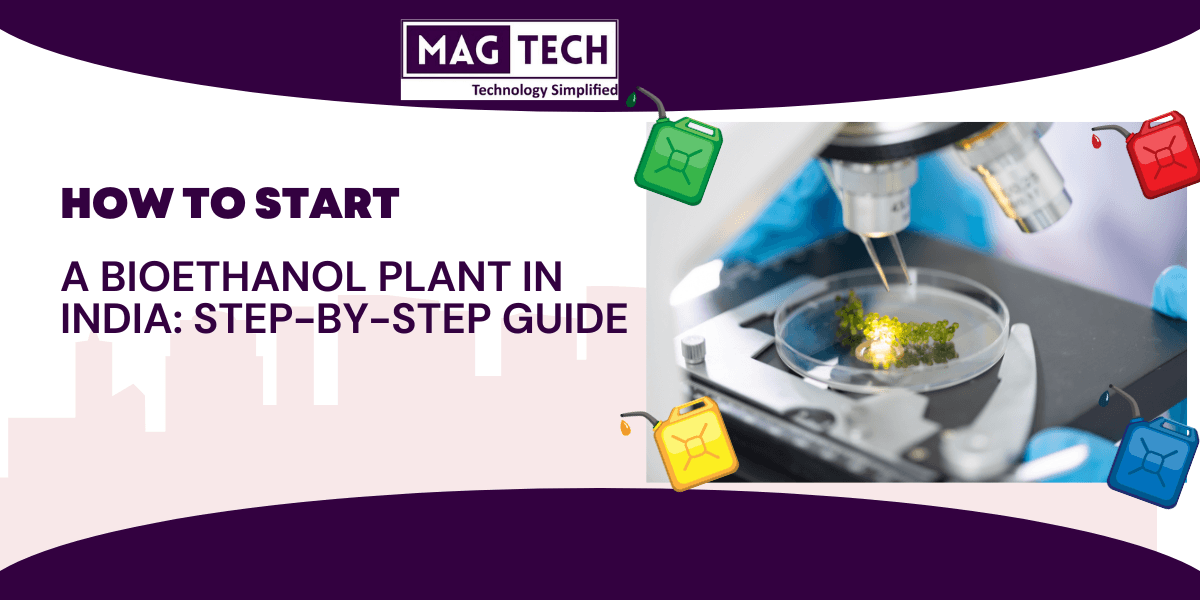Exploring biodiesel plant cost in India, considering capacities and required accessories based on raw materials. However, the investment required is a crucial factor for entrepreneurs and companies looking to enter this sector.
India, with its diverse agricultural sector and commitment to reducing carbon emissions, is an ideal location to set up biodiesel plants.
Understanding Biodiesel Plant Capacities
The capacity of a biodiesel plant is one of the most significant determinants of biodiesel plant cost.
A biodiesel plant’s capacity is the amount of biodiesel produced per day in the industry.
This volume directly impacts the scale of the investment, as larger capacities require more extensive infrastructure,
advanced technology, a larger workforce, and a wider supply network for raw materials and distribution.
In India, plants can range in capacity from 10,000 liters per day (10 KLPD) to 100,000 liters per day (100 KLPD), and even beyond.
The capacity you choose depends on several factors, including the availability of raw materials, the scale of your operations, and your target market.
Factors Influencing Capacity Decision
There are some of the most important factors that can influence your decision concerning the capacity of a biodiesel plant.
Table of Contents
Toggle1. Availability of Raw Materials
The heart of a biodiesel production plant is its feedstock. In India, common raw materials include non-edible vegetable oils, used cooking oil, animal fats, and other waste oils. The proximity to a consistent and affordable supply of these materials is crucial.
Large-capacity plants (50 KLPD to 100 KLPD) need dependable raw material sources to prevent operational disruptions and financial losses.
2. Scale of Operations
The intended scale of operations is intrinsically linked to the plant’s capacity.
For entrepreneurs targeting local markets or possessing limited initial capital, starting with a capacity ranging between 10 KLPD to 100 KLPD might be prudent.
Conversely, enterprises aiming for regional or national market penetration from the outset might opt for higher capacities.
3. Target Market
Understanding the demand within your target market is highly critical.
For instance, a plant situated in a region with high demand from transportation or agricultural sectors may require higher capacity to meet the market needs effectively.
Additionally, the decision might be influenced by any government mandates requiring diesel to be blended with a certain percentage of biodiesel, thus defining a clear market demand.
4. Financial Resources
Larger capacities require more significant investments not only in production facilities but also in storage, logistics, and distribution networks.
The investor’s financial capability and willingness to engage with financial institutions for loans or to attract investors can significantly determine the feasible capacity. You can apply for loan from a bank, know-how
5. Regulatory Considerations
India’s regulatory environment regarding biodiesel production includes permits, environmental clearances, and safety regulations.
Also, high-capacity plants face more stringent scrutiny given their larger environmental footprint.
Understanding and planning for these regulatory compliances is crucial when deciding on capacity.
Capacity vs. Biodiesel Plant Cost
The cost of setting up a biodiesel plant escalates with capacity. Understanding these costs is important for entrepreneurs and investors planning to venture into the biodiesel production industry.
For instance, a 10 KLPD plant might require an investment of around INR 3.5 crores, while a 100KLPD facility could reach INR 15 crores.
This increase in biodiesel plant cost is attributed to the need for larger premises, more sophisticated machinery, greater amounts of raw material, and increased manpower.
However, economies of scale can play a beneficial role in larger capacities. Although the initial investment is higher, the cost per unit of biodiesel produced can decrease.
This could potentially result in higher profit margins, particularly if the operational efficiencies are maximized and the market demand is consistent.
Biodiesel Plant Cost Analysis by Capacity
Before discussing the biodiesel plant cost breakdowns, it is important to note that we are not including the price of land. This is because land costs can vary dramatically based on location, proximity to raw material sources, and target markets.
Also, please note that the setup costs outlined below are estimated figures that could fluctuate based on several factors, including technology choice, raw material types, design complexities, regional pricing dynamics for machinery and labor, etc.
1. 10 KLPD
Total Project Cost: Approximately INR 3.5 crores
Small-scale operations like a 10KLPD plant require a significant initial investment. This is mainly due to the technology and machinery needed to process biodiesel.
The accessories cost, which includes pumps, filters, and safety equipment, among others, is influenced by the specific raw materials used, which dictate the type of processing equipment required.
2. 20 KLPD
Total Project Cost: About INR 5 crores
Doubling the capacity significantly raises the investment. The reason is the need for larger equipment, additional storage capacity for both raw materials and finished products, and probably more sophisticated technology to maintain efficiency at a larger scale.
3. 30 KLPD
Total Project Cost: Approximately INR 6.52 crores
A 30 KLPD capacity suggests a medium-scale operation that balances between the efficiency of larger plants and the agility of smaller setups. The proportional increase in accessory costs reflects the need for more diversified and capable machinery and safety equipment.
4. 50 KLPD
Total Project Cost: Roughly INR 8 crores
Accessories Cost: Estimated at INR 1 crore
A 50KLPD plant is significantly more complex, needing advanced technological installations, larger storage tanks, and sophisticated control systems to manage the production process.
The accessories play a crucial role in enhancing production efficiency and ensuring product quality.This is the most economically viable capacity in terms of ROI.
5. 100 KLPD
Total Project Cost: Around INR 15 crores
Accessories Cost: Around 3.5 Crore.
Large-scale operations, such as a 100KLPD plant, require substantial investment not just in the basic setup but also in infrastructure supporting logistics, raw material processing, and product distribution.
The accessories here not only cover production but also extensive safety, quality control, and possibly automation technologies to enable scalable operations.
Implications
These cost breakdowns show that biodiesel plant investment isn’t linear in relation to capacity.
Instead, it showcases economies of scale, where larger capacities potentially offer reduced costs per liter of biodiesel produced,
thanks to more efficient use of resources and technological advances.
However, the increased capital requirement also means a higher risk, in making the decision of selecting the plant capacity. Making this strategic choice requires thorough market research, material assessments, and financial planning.
It’s also important to note that these figures are subject to change based on technological advancements, fluctuations in equipment and material costs, regulatory changes, and the evolving biofuel market dynamics.
Therefore, while the biodiesel plant cost breakdown provides a foundational understanding, personalized and dynamic financial planning is crucial for anyone looking to enter the biodiesel production industry.
A Step-by-step Guide for Biodiesel Capacity Expansion
As the demand for cleaner, greener alternatives to fossil fuels continues to surge, existing biodiesel plants face the notable challenge of scaling up their operations.
Yet, the path to expanding capacity has several complexities, from market dynamics to raw material sourcing and beyond.
1. Understanding Market Demand
The cornerstone of any capacity expansion decision lies in a robust market analysis. The biodiesel industry, with its roots deeply entwined in the global push for sustainability, is uniquely sensitive to shifts in regulatory policies, environmental advocacy, and fossil fuel markets.
Producers looking to expand must first harness a deep understanding of these dynamics, forecasting demand with precision and identifying potential niches.
For instance, regions with stringent environmental regulations may present ripe opportunities for biodiesel as industries and transportation sectors seek compliant fuels.
2. Securing Raw Materials
Biodiesel’s sustainability promise, however, hinges on the availability and viability of feedstocks.
Whether it’s recycled cooking oil, soybean oil, or emerging feedstocks like algae, the continuity and cost of raw materials significantly impact production.
Strategic expansion plans, therefore, include the development of reliable supply chains, fostering relationships with suppliers, and exploring diversification of feedstock sources to mitigate risks posed by market volatility and competition for resources.
3. Understanding Regulatory Aspects
Regulatory compliance is not just a legal obligation but a strategic asset in the biodiesel sector.
Expansion plans must account for the cost and complexities of adhering to emissions standards, renewable fuel mandates, and safety regulations, which can vary dramatically across jurisdictions.
Anticipating future regulatory shifts can also provide a competitive edge, allowing plants to proactively adapt and capture market share as policies evolve.
4. Leveraging Technology for Efficiency
Technological advancements offer a strategic lever for capacity expansion. Innovations in process efficiency, yield optimization, and feedstock processing can dramatically increase output without the need for physical expansion.
For example, the adoption of next-generation transesterification processes, as seen in successful European biodiesel companies, has enabled significant capacity increases.
5. Financial Foresight
At the heart of capacity expansion lies the question of financing. The capital-intensive nature of scaling production requires meticulous financial planning, from identifying sources of investment to forecasting returns and conducting risk assessments.
Grants, green financing options, and partnerships can play a crucial role in fueling expansion, making financial acumen as critical as technological or operational expertise.
Shifting Through Expansion Through Innovation and Policy
The biodiesel industry stands on the brink of a transformative era, propelled by rapid technological advancements and a global impetus toward environmental sustainability.
As we look toward the future, several key factors are poised to drive significant expansions in biodiesel plant capacities, reflecting a broader shift in energy production paradigms.
1. Harnessing Emerging Technologies for Greater Capacities
At the forefront of technology, there are promising prospects for revolutionizing biodiesel production.
One of the most compelling developments is the advent of genetically modified organisms (GMOs) designed to yield higher oil content. This biotechnological breakthrough has the potential to expand
feedstock sources and improve oil extraction rates, directly influencing plant capacities by enhancing input-output efficiencies.
Parallel to biotechnology advances, process innovations like microwave-assisted transesterification offer a leap in production methodologies.
By significantly reducing reaction times and improving biodiesel yields, these cutting-edge techniques can scale up production capacities while optimizing operational costs.
Such advancements point towards a near-future scenario where
1. Plants can achieve greater outputs and flexibility in feedstock utilization,
2. Setting a new benchmark for efficiency and sustainability in biodiesel production.
2. Environmental Policies
Therefore, environmental policies across the globe are increasingly aligning with the goals of carbon neutrality,
acting as milestones for the expansion of biodiesel production.
Governments are combining subsidies, tax breaks, and blending mandates to boost biodiesel production capacities.
Furthermore, the imposition of stricter environmental standards across industries is creating a robust demand for cleaner fuel alternatives,
encouraging biodiesel plants to ramp up production to meet these emerging needs.
The policy workarounds are, thus, not only creating a conducive environment for biodiesel adoption. but also actively encouraging producers to invest in capacity expansion.
This dynamic interplay between policy frameworks and industry growth underscores the essential role of legislative support in facilitating the transition toward sustainable biofuels.
3. Navigating Market Dynamics for Strategic Growth
Moreover, beyond technological and policy-driven factors, market dynamics play a crucial role in shaping the future of biodiesel capacities.
Crude oil price volatility and rising demand for renewables make biodiesel an appealing alternative. This market sentiment is expected to drive consistent growth in demand, prompting biodiesel producers to proactively expand their capacities.
Moreover, the expansion into niche markets, such as aviation and marine biodiesel, offers a plethora of unprecedented opportunities for growth.
While these sectors were traditionally reliant on heavy fossil
fuels, they are now in the midst of a sustainability breakthrough, seeking renewable alternatives to meet environmental commitments.
Biodiesel producers can grow their business by meeting the increasing demand in new markets beyond ground transport.
Charting a Sustainable Path Forward
The future goal for the biodiesel industry :
Increase production to meet the rising demand for renewable fuels and help achieve a sustainable, carbon-neutral world.
By using new technologies, taking advantage of government policies, and understanding market trends,
Additionally, biodiesel producers can grow their businesses in a way that benefits both their profits and the environment


